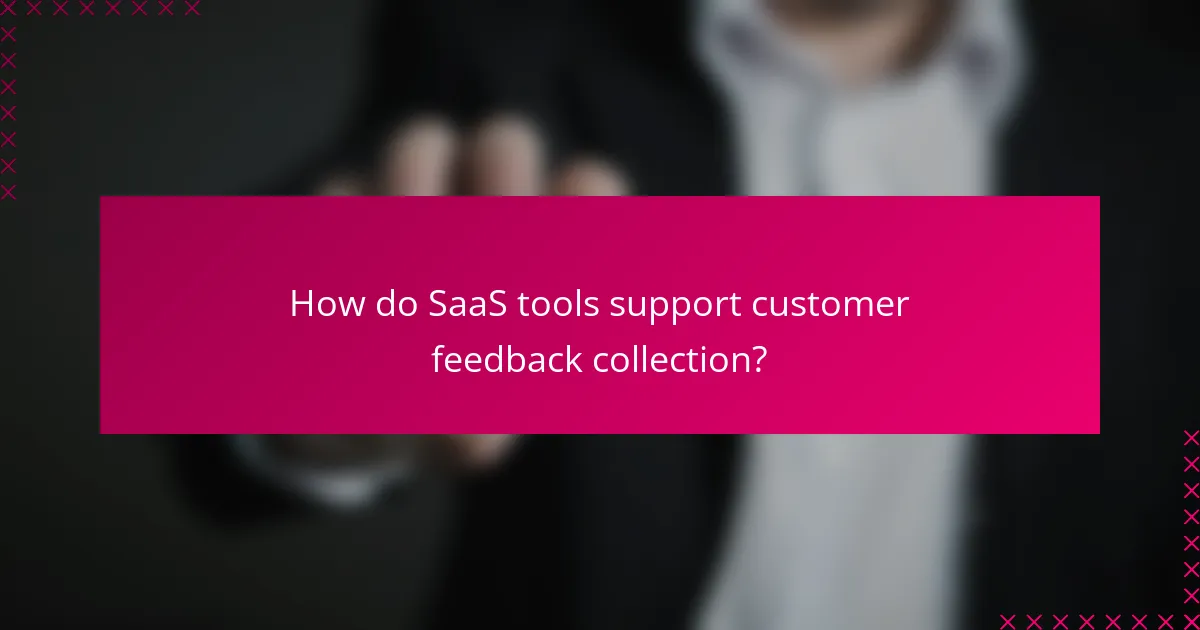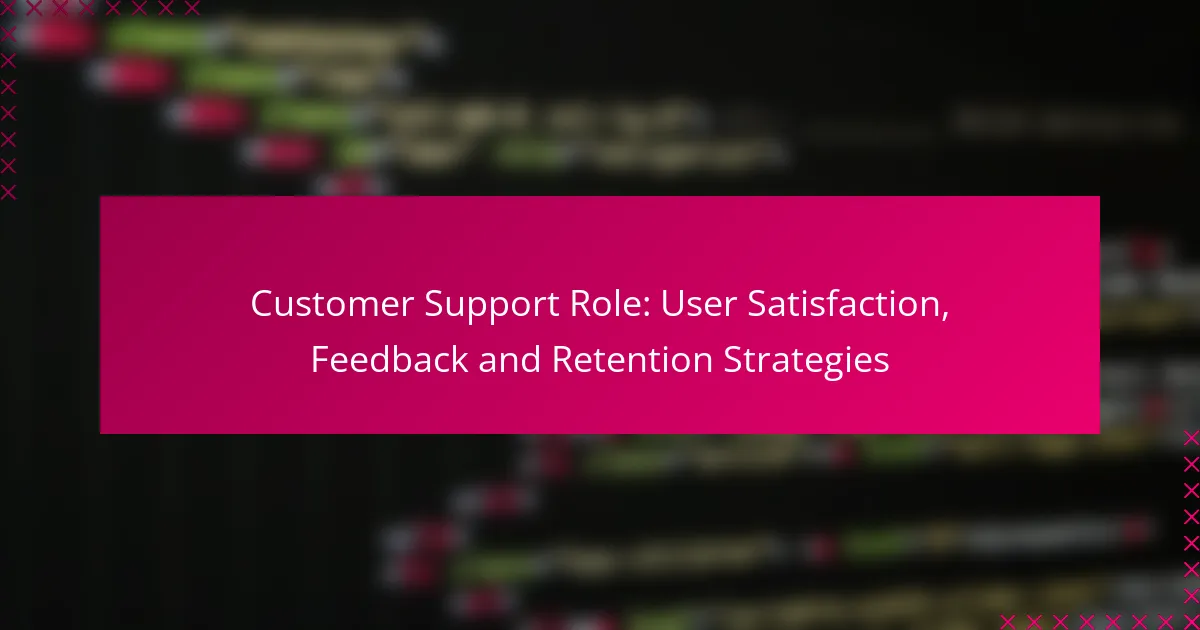In today’s competitive landscape, customer support plays a crucial role in enhancing user satisfaction and fostering loyalty. By delivering timely and personalized assistance, support teams can create positive experiences that encourage retention. Implementing effective feedback strategies allows businesses to understand customer needs better, identify areas for improvement, and strengthen their relationships with clients.

How can customer support enhance user satisfaction?
Customer support can significantly enhance user satisfaction by providing timely, effective, and personalized assistance. By focusing on the needs and preferences of users, support teams can create positive experiences that foster loyalty and retention.
Personalized interactions
Personalized interactions involve tailoring communication and support to meet individual user needs. This can include addressing customers by name, remembering past interactions, and understanding their preferences. Such approaches make users feel valued and understood, which can lead to increased satisfaction.
For example, using customer relationship management (CRM) software can help support agents access user history quickly, enabling them to provide relevant solutions. This personal touch can differentiate your service from competitors.
Proactive communication
Proactive communication means reaching out to users before they encounter issues. This can involve sending updates about service changes, maintenance schedules, or potential disruptions. By keeping users informed, companies can prevent frustration and demonstrate that they care about their experience.
For instance, notifying users of a system upgrade in advance allows them to prepare and reduces the likelihood of negative feedback. Regular check-ins can also help identify potential issues early, allowing for timely resolutions.
Efficient issue resolution
Efficient issue resolution focuses on addressing user problems quickly and effectively. This can be achieved through well-trained support staff, clear processes, and the use of technology like chatbots for immediate responses. Reducing wait times and providing straightforward solutions can greatly enhance user satisfaction.
Implementing a ticketing system can help prioritize issues based on urgency, ensuring that critical problems are resolved first. Aim to resolve issues within a single interaction whenever possible to minimize user effort.
Utilizing customer feedback
Utilizing customer feedback involves actively seeking and analyzing user opinions to improve services. Regular surveys, feedback forms, and direct conversations can provide valuable insights into user satisfaction levels and areas for improvement. Listening to customers shows that their opinions matter.
Consider implementing a Net Promoter Score (NPS) survey to gauge user loyalty and satisfaction. Analyzing feedback can help identify trends and inform decisions on service enhancements, ultimately leading to better user experiences and retention rates.

What feedback strategies improve retention?
Effective feedback strategies that enhance customer retention focus on understanding customer needs and satisfaction levels. By implementing regular feedback mechanisms, businesses can identify areas for improvement and foster loyalty among their clientele.
Regular surveys and polls
Regular surveys and polls are essential tools for gathering customer insights. They allow businesses to assess customer satisfaction and identify trends over time. Aim to conduct these surveys quarterly or biannually to keep a pulse on customer sentiment.
When designing surveys, keep them concise and focused. Use a mix of open-ended questions and multiple-choice formats to capture both qualitative and quantitative data. For example, asking customers to rate their experience on a scale of 1 to 10 can provide clear metrics for analysis.
Net Promoter Score (NPS)
The Net Promoter Score (NPS) is a widely used metric that gauges customer loyalty by asking how likely customers are to recommend your business to others. This single-question survey can be a powerful indicator of overall satisfaction and future retention.
To calculate NPS, subtract the percentage of detractors (customers who rate you 0-6) from the percentage of promoters (those who rate you 9-10). A score above 0 is generally considered good, while a score above 50 is excellent. Regularly tracking NPS can help identify shifts in customer loyalty.
Customer satisfaction (CSAT) metrics
Customer satisfaction (CSAT) metrics measure how satisfied customers are with specific interactions or experiences. Typically assessed through short surveys immediately following a purchase or service interaction, CSAT provides immediate feedback on customer experiences.
CSAT is usually measured on a scale from 1 to 5 or 1 to 10, where higher scores indicate greater satisfaction. Aim for a CSAT score of 80% or higher to signify strong customer satisfaction. Analyzing CSAT results can help pinpoint areas needing improvement, allowing for targeted enhancements in service or product offerings.

How do SaaS tools support customer feedback collection?
SaaS tools facilitate customer feedback collection by providing platforms that streamline communication and data gathering. These tools help businesses understand user satisfaction, gather insights, and enhance retention strategies through structured feedback mechanisms.
Zendesk for ticketing and feedback
Zendesk is a customer service platform that allows businesses to manage customer inquiries and feedback through a ticketing system. Users can submit tickets regarding issues or suggestions, which can be prioritized and tracked for resolution. This organized approach helps ensure that customer feedback is not overlooked and is addressed promptly.
To maximize the effectiveness of Zendesk, companies should categorize tickets based on urgency and type of feedback. Regularly reviewing these tickets can reveal common issues and trends, enabling proactive improvements in products or services.
SurveyMonkey for user surveys
SurveyMonkey is a popular tool for creating and distributing user surveys, allowing businesses to gather structured feedback from customers. It offers customizable templates and analytics features that help interpret survey results effectively. This can be particularly useful for measuring customer satisfaction and identifying areas for improvement.
When using SurveyMonkey, keep surveys concise and focused to encourage higher response rates. Aim for a mix of quantitative and qualitative questions to gain deeper insights into user experiences. Consider sending surveys after key interactions to capture timely feedback.
Intercom for real-time feedback
Intercom is a messaging platform that enables businesses to collect real-time feedback from users through chat and messaging features. This immediate interaction allows companies to address concerns as they arise, enhancing customer satisfaction and retention. Users can provide feedback directly during their experience, making it more relevant and actionable.
To effectively utilize Intercom, ensure that customer support representatives are trained to engage with users and solicit feedback during conversations. Implementing automated prompts for feedback can also streamline the process, ensuring that valuable insights are captured without overwhelming customers.

What role does data analysis play in customer support?
Data analysis is crucial in customer support as it helps organizations understand user behavior, measure team performance, and enhance product features. By leveraging data, companies can make informed decisions that lead to improved user satisfaction and retention.
Identifying trends in user behavior
Data analysis allows support teams to identify patterns in user interactions and preferences. By examining metrics such as ticket volume, response times, and customer feedback, teams can pinpoint common issues and areas for improvement.
For instance, if a significant number of users report difficulties with a specific feature, it signals a need for further investigation. Tracking these trends over time can help predict future support needs and allocate resources effectively.
Measuring support team performance
Analyzing data related to support team performance provides insights into efficiency and effectiveness. Key performance indicators (KPIs) such as average resolution time, customer satisfaction scores, and first contact resolution rates are essential metrics to monitor.
Regularly reviewing these metrics helps identify high-performing agents and those who may need additional training. Establishing benchmarks can also motivate teams to improve their service delivery and enhance overall user experience.
Improving product features based on feedback
Customer feedback is a goldmine for product improvement, and data analysis plays a vital role in interpreting this information. By aggregating feedback from various channels, support teams can highlight common requests and pain points that users experience.
For example, if users frequently request a particular feature, this feedback can guide product development priorities. Implementing changes based on user input not only enhances the product but also fosters a sense of community and loyalty among customers.

How can companies implement effective retention strategies?
Companies can implement effective retention strategies by focusing on customer satisfaction, gathering feedback, and creating loyalty initiatives. These strategies help maintain a strong relationship with clients, encouraging repeat business and long-term loyalty.
Loyalty programs and incentives
Loyalty programs and incentives are designed to reward customers for their continued patronage. These programs can take various forms, such as points systems, discounts, or exclusive offers, which encourage customers to return and engage more frequently.
When creating a loyalty program, consider the preferences of your target audience. For example, a coffee shop might offer a free drink after a certain number of purchases, while an online retailer could provide discounts on future orders. Tailoring incentives to customer interests can significantly enhance their effectiveness.
To ensure the success of loyalty programs, regularly evaluate their performance and gather customer feedback. This can help identify what resonates with customers and what may need adjustment. Avoid overly complicated structures that can confuse customers; simplicity often leads to higher engagement.
